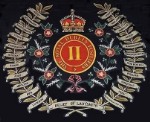" ... the Queens own they were a nice lot..."
[thought Molly sarcastically, late at night on June 16, 1904]
The British Army regiment, the Queen's Own Cameron Highlanders, appears in three episodes of Ulysses and its soldiers had a life-long effect on the character Molly Bloom. Until 1881, it was styled the 79th Regiment of Foot.
n/ U (Gabler) 14:1403; 17:1987; 18:544-57.
Cameron Highlanders
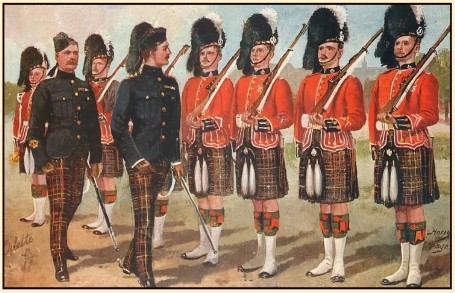
From a postcard c. 1881, "Inspecting the Guard."
The red-coated soldier on the right has two good conduct badges on his left sleeve. The soldier to his immedeiate right has a marksmanship badge. The inspecting officer, with sword, holds the rank of captain and is the "officer of the day." Behind him, in an officer's uniform with badge of rank on his sleeve and holding a swagger stick, is the battalion's Regimental Sergeant Major. In 1880, the War Office made holders of the highest enlisted grade "warrant officers."
Cameron Highlanders in Gibraltar
At the start of 1879, the regiment was in Maryhill Barracks in Glasgow's northern suburbs. On May 15th, the War Office ordered it to embark for Gibraltar. At the time, the Camerons were understrength with 20 officers, 35 sergeants, 18 drummers, and only 485 rank and file. The regiment arrived in Gibraltar on June 15th. As shown in the Gibraltar Directory, the unmarried officers were quartered in the Spanish Pavillion, in the Town's center adjacent to the Roman Catholic Cathedral, Santa Maria.
The Gibraltar Directory
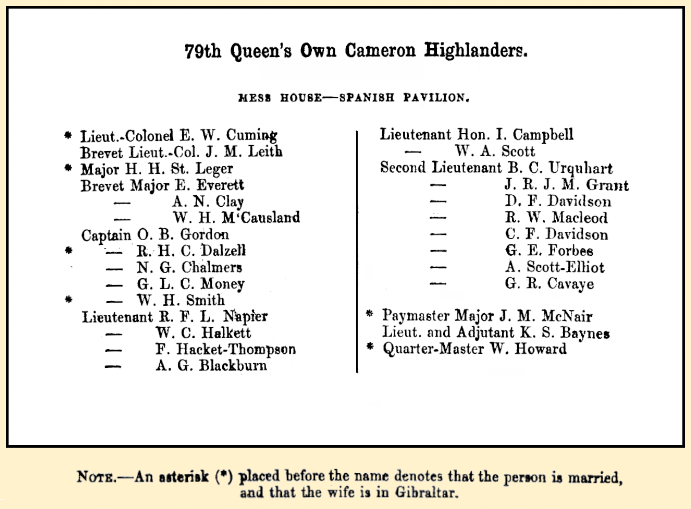
Location of the Spanish Pavillion
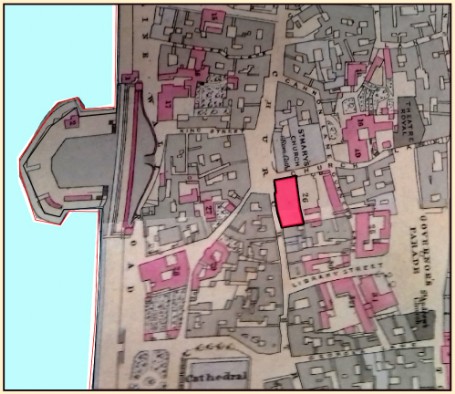
In September, the regiment received from the 42nd Royal Highlanders (Black Watch) 2 sergeants, 2 corporals, and 153 privates. Molly thought the Black Watch looked splendid when she saw them in Dublin.
n/ Ulysses (Gabler) 18: 400-01.
Cameron Highlanders, c. 1880
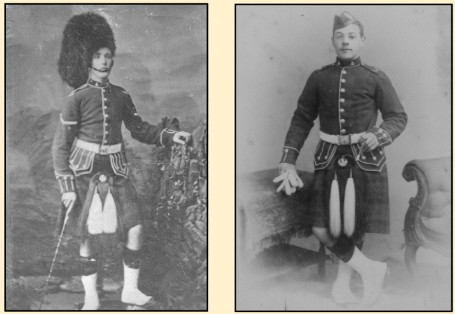
Later in the year, the regiment received news of the soon to be implemented regimental amalgamation scheme whereby they would be the 2nd Battalion of a new regiment with the 42nd (Black Watch) the 1st Battalion. The regimental tartan would be that of the Black Watch. The Camerons, all ranks, opposed such amalgamation.
In January 1881, the acting commander, Lt.-Col. J.M. Leith, telegramed the War Office: "No. - The Cameron Highlanders will not adopt the 42nd tartan." Col. Leith then wrote to the Adjutant-General as follows:
In Gibraltar, 30th January, 1881
SIR,
I have the honour to forward a copy of a telegram despatched by me this morning in reply to your telegram received yesterday evening, which, in transmission through Spain, had become somewhat illegible.
It was with the greatest sorrow that the officers of the 79th Cameron Highlanders heard of the proposal to deprive the regiment of the Cameron tartan, worn by them for so many years and regarded with pride and affection by all ranks. No one serving in the 79th would willingly adopt the tartan of the 42nd regiment, which would virtually mean the extinction of the 79th Cameron Highlanders as a regiment.
May I most respectfully request that you will have the goodness to move His Royal Highness the commander-in-chief to preserve, if possible, for the regiment that tartan which has been the distinctive dress since they were raised in 1793 by Sir Alan Cameron, and, as the inscriptions on the colours testify, has been worn with honour in many hard-fought battles.
I have the honour to be, Sir,
Your obedient servant,
J. M. LEITH,
Lieutenant-Colonel,
Commanding 79th Queen's Own Cameron Highlanders
Nothing further was heard of the matter until the Secretary of State for War, speaking in the House of Commons on March 3rd, announced the 79th would be the army's only single-battalion regiment. (Click on the link and the Hansard's page from Parliament's website will open in a popup window.)
On March 15, 1882, the regiment received from its depot 1 sergeant and 119 rank and file.
n/ Historical Records of the 79th Queen's Own Cameron Highlanders (1886).
Barracks Occupied by the Men
Upon the Camerons arrival in Gibraltar, the men were quartered at Buena Vista Barracks.
March 10, 1880: Relocated to Town Range Barracks.
December 27, 1880: HQ and six companies sent to South Barracks; four companies sent to quarters in the Wellington Front gun emplacements.
January 3, 1881: Three of the companies in the Wellington Front moved to South Barracks.
The regiment remained at South Barracks, with one company in the Wellington Front, until its departure from Gibraltar.
n/ Historical Records of the 79th Queen's Own Cameron Highlanders (1886), 161-65.
Molly Bloom remembers the men:
"... what a man looks like with his two bags full and his other thing hanging down out of him or sticking up at you like a hatrack ... that disgusting Cameron highlander behind the meat market or that other wretch with the red head behind the tree where the statue of the fish used to be when I was passing pretending he was pissing standing out for me to see it ... the Queens own they were a nice lot ..."
n/ Ulysses (Gabler) 18:544-48.
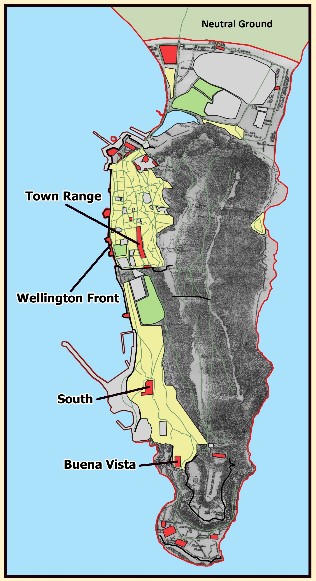
Departure from Gibraltar
In 1882, nationalist army officers took control of Egypt's government. On June 11th rioters in Alexandria killed 50 to 150 Europeans and several European nations sent warships to evacuate their nationals. The British government placed a naval squadron just off-shore of Alexandria. On July 11th the British ships bombarded the forts at Alexandria. After the Egyptian guns were silenced, British troops landed and took control of the city.
On July 14, 1882, the War Office ordered the Camerons to Egypt. Before leaving Gibraltar, it placed a memorial plaque in the Presbyterian church to hounor its men who died in Gibraltar, one officer and eight rankers. On August 7th, the Cameron Highlanders, 826 men, all ranks, boarded the troopship HMS Orontes for Alexandria.
Molly recalls the regiment's departure:
"... well the Surreys relieved them ..."
n/ Historical Records of the 79th Queen's Own Cameron Highlanders (1886); Ulysses (Gabler) 18:549
Cameron Highlanders in 1882
As noted above, the Camerons was not paired with another regiment in the amalgamations of 1881. It would not have a second regular battalion until 1897. While the regulars were in Molly's Gibraltar, the regiment consisted of the following components:
Depot at Inverness
1/Cameron Highlanders, regulars
2/Cameron Highlanders, the Highland Light Infantry Militian/ Hart's New Annual Army List, 1882.
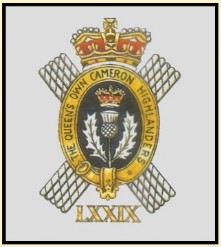
Badge
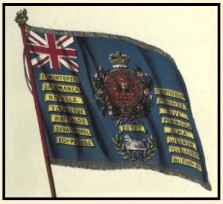
Colours, After Egypt
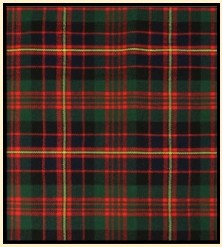
Tartan
Documents on Other Websites
To download the file, click on the document name or its website icon. The file will open from the other website in a new browser window. See Download Instructions if you're unfamiliar with the website.
MacKenzie, Ewart, and Findlay, Historical Records of the 79th Queen's Own Cameron Highlanders (London: Hamilton, Adams, 1887). On the Internet Archive website,
From the Scots and Welsh Pinterest board of Tom "Roy" Burkey. For that board, click on the icon to the right.
Links to Other Websites
Note: The webpages will open in new windows.
Click on the link to go to that page of the website. Click on the icon to go to the website's home page.
The regiment's page on the museum's website. Gives the Cameron's history through its amalgamation with the Seaforth Highlanders.
Page from The Great Scottish Clans, a website of Galloglas Films, Ltd.
Summarizes each campaign in which the regiment participated through WWII. Includes some casualty tallies. Selected bibliography near the bottom. From the website of the retailer, North East Medals.
Page on the website of the Highlanders' Museum. The museum, principally for the Seaforth and Cameron Highlanders, is located at the national historic site, Fort George, Ardsier, Inverness.
[ You are at www.majortweedy.com>Molly's Gibraltar>Cameron Highlanders ]
